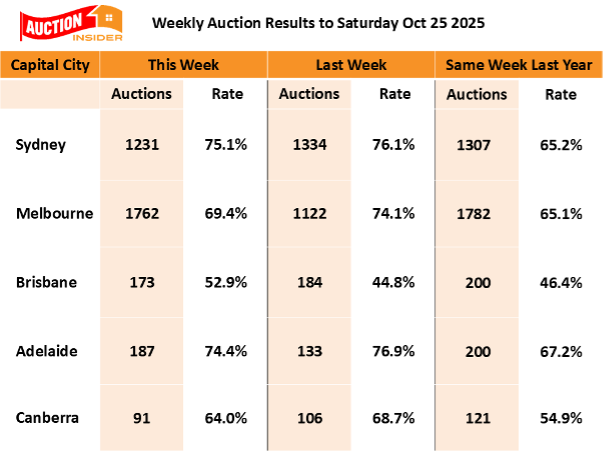
Key takeaways
Rental markets remain tight – Vacancy rates across most capitals are still below 2%, keeping rents elevated despite a few signs of stabilisation.
House rents steady, units more volatile – Sydney remains the priciest city for both houses ($800/week) and units ($750/week), while Hobart saw the biggest monthly house rent rise (+3%).
Home-building approvals keep falling – National approvals dropped another 4.7% in August after a 9.5% fall in July, with unit approvals plunging 8.1%.
Supply crunch deepens – Total capital city dwelling approvals are now nearly 28% below their 2016 peak, signalling a worsening shortage ahead.
Queensland bucks the trend – The Sunshine State recorded a modest 3.7% rise in approvals, while most others declined.
Auction markets resilient – Despite the usual spring surge in listings, clearance rates remain strong: Sydney (75%), Melbourne (69%), and Adelaide (74%).
Buyer confidence returning – Robust clearance rates and steady demand suggest growing optimism that interest rates have peaked.
Outlook: rents to rise, supply to tighten – With limited new construction and strong migration, both rental and price pressures are set to persist into 2026.
There’s a lot happening right now in Australia’s property scene — rents are still sky-high, new home building is falling off a cliff, and yet, auction markets are holding remarkably firm.
So what’s really going on behind the headlines?
Are we finally seeing a turning point in the rental crisis, or is this just the calm before the next surge?
And with home-building approvals plunging again, what does that mean for future housing supply — and for property prices?
That’s what Dr. Andrew Wilson and I discuss in this week’s Property Insiders chat as we uncover what’s really going on in Australia’s property markets.
Rental Markets Mixed Over September
Capital city rental markets have reported mixed results over September, with house rents and vacancy rates generally steady, although unit rents recorded more diverse outcomes over the month.
Most capitals recorded steady house rents over September compared to the previous month; however, rents were higher in Hobart and Canberra by 3.0% and 1.5% respectively, with Melbourne house rents falling by 0.4%.
Sydney continued to report the highest capital city house rents over September steady at $800 per week with Hobart still the most affordable but higher at $600 per week.
Most capitals have recorded solid annual increases in house rents with Hobart the highest rising 9.1%, Perth higher by 6.9%, Brisbane increased 5.1%, Adelaide up 4.1 % and Canberra up 2.6%. Sydney and Darwin annual house rents were each flat with Melbourne however down 3.3% over the year.
House vacancy rate changes over September were mixed however all remain at low levels well below 2.0% indicating ongoing shortages of available homes and likely to eventually place upward pressure on rents.
Median Weekly Asking Rents September 2025
HOUSES
| Rent | Month | Year | Vacancy Rate | Change | |
| Sydney | $800 | 0.0% | 0.0% | 1.2% | ↔ |
| Melbourne | $580 | -0.4% | -3.3% | 1.4% | ↔ |
| Brisbane | $670 | 0.0% | 5.1% | 1.0% | ↑ |
| Adelaide | $630 | 0.0% | 4.1% | 1.1% | ↑ |
| Perth | $700 | 0.0% | 6.9% | 1.0% | ↑ |
| Hobart | $600 | 3.0% | 9.1% | 0.4% | ↑ |
| Darwin | $750 | 0.0% | 0.0% | 0.6% | ↔ |
| Canberra | $698 | 1.5% | 2.6% | 1.4% | ↔ |
Capital city unit rental markets were generally subdued over September with most capitals recording steady or lower rents compared to the previous month.
Melbourne was the top performer over the month with unit rents up by 1.2% followed by Brisbane and Perth each higher by 0.8%. Sydney and Darwin unit rents were steady with Canberra, Adelaide and Hobart falling by 0.4%, 0.5% and 9.0% respectively.
Annual unit rents have increased in all capitals with Dawin, Perth and Adelaide highest up by 7.6%, 7.4% and 6.5% respectively.
Sydney remains the clear leader for weekly unit rents steady at $750, with Hobart still the most affordable and lower at $469 per week.
Similar to houses, capital city unit vacancy rate changes were mixed over September however most remain exceptionally low with the exception of Melbourne and Canberra that continue above 2%.
Median Weekly Asking Rents September 2025
UNITS
| Rent | Month | Year | Vacancy Rate | Change | |
| Sydney | $750 | 0.0% | 0.7% | 1.3% | ↑ |
| Melbourne | $597 | 1.2% | 3.8% | 2.3% | ↑ |
| Brisbane | $655 | 0.8% | 4.8% | 1.2% | ↓ |
| Adelaide | $533 | -0.5% | 6.5% | 0.9% | ↓ |
| Perth | $655 | 0.8% | 7.4% | 1.0% | ↓ |
| Hobart | $469 | -9.0% | 4.2% | 1.2% | ↓ |
| Darwin | $600 | 0.0% | 7.6% | 1.1% | ↑ |
| Canberra | $570 | -0.4% | 3.6% | 2.6% | ↑ |
Although rental markets reported mixed conditions over September, vacancy rates remain generally low for both houses and units, with higher rents accordingly a continuing prospect.
Home building approvals fall
Watch this week’s Property Insiders chat as Dr Andrew Wilson paints a sobering picture for future housing supply.
Building approvals fell another 4.7% in August, following a 9.5% decline in July
- Houses dropped 2.2%, while unit approvals fell a sharper 8.1%.
- Annual approvals are down significantly, with total capital city approvals 27.9% below their 2016 peak, and unit approvals 44.6% lower than the peak.
Queensland was the only state to buck the trend, recording a modest 3.7% increase in total approvals.
This contraction in new dwelling approvals continues a worrying multi-year trend. It means we’re simply not building enough homes to meet demand – particularly with Australia’s population still expanding strongly through migration.
Fewer new homes today mean even greater pressure on rents and prices tomorrow.
It’s a perfect storm: record migration, limited stock, construction industry constraints, and escalating development costs.
And of course, all new dwellings coming onto the market will be much more expensive moving forward, as the cost to construct them is so much higher than it was a few years ago.
As you can see from the two charts below, home building approvals are down significantly from their 2016 peak
Auction Markets Hold the Line Despite Usual Mid-Spring Listings Surge
Auction clearance rates have remained generally steady despite yet another week of significant listing numbers as the mid-spring market peaks.
The national weekend auction market reported an average clearance rate of 67.2% over the past week, slightly lower than the 68.1% reported the previous week but still well ahead of the 56.7% reported over the same week last year.
Auction markets will ease over the coming weeks as holidays distract some sellers in the short term, although buyer activity is set to remain robust.
Some Final Thoughts
Taken together, these figures confirm what many investors already sense: We’re still in a structural housing shortage, and the solution isn’t coming quickly.
While renters continue to face pressure, investors with well-located assets are benefiting from rising rents, tight supply, and steady buyer competition in quality markets.
If approvals continue to fall while migration remains elevated, it’s hard to see how property prices could materially fall in the medium term.
Instead, the fundamentals continue to support ongoing capital growth once interest rates ease further.


















